© Steven J. Cary, June 22, 2022
Marine Blues have been observed all over New Mexico, sometimes in good numbers but usually only a few because conditions are so poor. Have you seen this species recently? If you have not, then are you truly trying? I have an inner sense that Marine Blues have all but replaced Reakirt’s Blues as the most routinely encountered blue in New Mexico. My memory tells me that Marine Blues were not common in northern New Mexico 40 years ago, but have expanded and thrived in recent decades. Is that an invented memory? When I reviewed my personal field notes from the early 1980s, it turns out that Marine Blues were in northern New Mexico at that time. A good reason to take and retain good field notes and not trust my memory.
For this June 2022 post I have several stories to present, mine and others, including three related directly to butterfly life histories. But first, please take note of the following announcements:
The U.S. Fish and Wildlife Service (USFWS) proposes to list another butterfly species of interest in New Mexico: the Great Basin Silverspot (Speyeria nokomis nokomis) (see image 1): https://www.govinfo.gov/content/pkg/FR-2022-05-04/pdf/2022-09446.pdf. Like the Sacramento Mountains Checkerspot, Nokomis is on very hard times.

This year, PEEC is expanding its annual Dorothy Hoard Memorial Butterfly Count to a new format. Traditionally, there was a one-day event visiting three sites on one day. This year, three guided “Butterfly Rambles” will be offered on three consecutive weekends. We hope more people will be able to join at least one “ramble” and with less invested in any specific day, one day of bad weather will not drown the entire event. Rambles are scheduled for three consecutive Saturday mornings: July 16, July 23, and July 30, all in the Los Alamos area of the Jemez Mountains. Watch for details on PEEC’s event page.
A Red-Winged Black Bird Tale, by Jim Von Loh, May 31, 2022. There are a few more butterflies showing up along the Rio and also more nectaring sources with a few whorled milkweed and Baccharis flowers opening, quite a few locations for spiny Chloracantha flowers, and the old staples of tamarisk up high and water speedwell down low. Of course this scenario changes sometime tomorrow or Thursday when the released irrigation flow in to downstream farmers will be bank-to-bank, inundating the low-down nectar sources. This (dry) year the flow is scheduled for only the month of July with some days in August the last time I read anything about it. In some recent past (wet) years it has gone into September/early October.
Blues are numerous, mostly Marine, but today there were some Western Pygmy and Acmon, as well. A few queens (image 2) have arrived the past two days, some are pretty tattered. Whites are becoming more numerous with checkered and cabbage present. The sleepy oranges were joined by a single (very large) southern dogface (image 3). Painted crescents are always numerous. Gray hairstreaks (image 4) are often present and today a great purple hairstreak found the milkweeds (image 5)!




I learned something today that sort of amazed me…It all began when I stepped too close to a red-winged blackbird’s youngsters hiding in some willows. The male RWBB immediately flew over my head and dropped his load (see image 6).

I’m glad I wear a hat! But the load fluttered a little with the wind and “landed” about a meter away on some caked sand (image 7). It was the RWBBs freshly captured and killed pipevine swallowtail, meant to feed to one of the babies.

What I actually learned is that the pretty ventral wing view above is all I’ve ever seen of this swallowtail, but when I walked around and looked at the butterfly into the angled sunlight, I saw this (image 8), and was kind of amazed. I’m fairly new to butterfly morphology and had no idea that so many ventral scales reflected a powdery blue color reminiscent of the dorsal wing scales of a red-spotted purple/admiral. I focused on the row of white dots to appreciate the “scale” of this color pattern.

SJC: Jim, thanks for the up-close natural history tour of the low-flow Rio Grande. The behavior of the RWBB is fascinating, your narration and photos no less so. I can add another wrinkle, if I may, to the point that Pipevine Swallowtails taste very bad because their caterpillars eat pipevine (Aristolochia watsoni in your area), which is full of chemicals that amaze phytopharmacologists. Red-spotted Admirals and female Black Swallowtails are colored radiant blue dorsally so as to mimic the yucky Pipevine Swallowtail, tricking birds into thinking they too are foul-tasting and presumably gaining some advantage . . . a second chance perhaps, after a predator bird recognizes the pattern and calls off its attack. Your RWBB clearly followed through with its attack on this swallowtail, but then thought better of his capture. It was too late for that individual butterfly, but thanks to its sacrifice, that particular bird will henceforth pose no threat to Pipevine Swallowtails, maybe even to the its mimics.
Now, let’s wrap up the weeks-long “Saga of the Mourning Cloaks” at the Randall Davey Audubon Center (RDAC). Recall oviposition on April 6 (see April blog), followed by hatching of eggs about three weeks later (see May blog), nicely coinciding with bud-break on the host hackberry tree. Since then, we have documented growth of larvae through multiple instars. During my visit to RDAC on May 24, I found quite a few larvae in final or near final instars (see image 9 below).
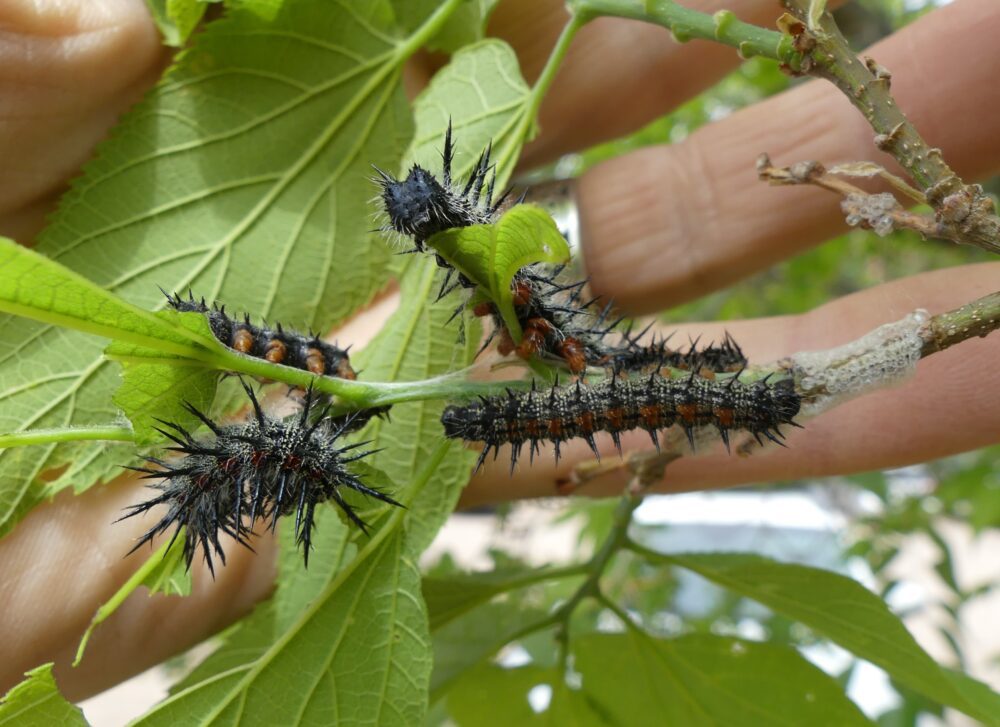
Two weeks later, when I visited on June 7, I found no active, living larvae whatsoever, despite thorough searches. I did find some caterpillar carnage on branches of the host hackberry tree, about 10 feet above ground. The carnage can be seen in image 10 below, where caterpillar carcasses are scattered along the branch. Some spider webbing is apparent. When I think back to earlier weeks, I think I saw these dead caterpillars but did not realize they were dead. They clearly died during early and middle instars. I fully expected high mortality among the cats, for that is the fate of most Lepidoptera larvae. I expected it might come in the form of bird predation, and probably there was some of that, though largely unobserved. However, hungry birds consume the entire larva and do not leave carcasses laying about. So these cats seem to have been killed by something that did not carry them away; I’m thinking mold, disease, bacteria, or something like that. Spiders maybe?
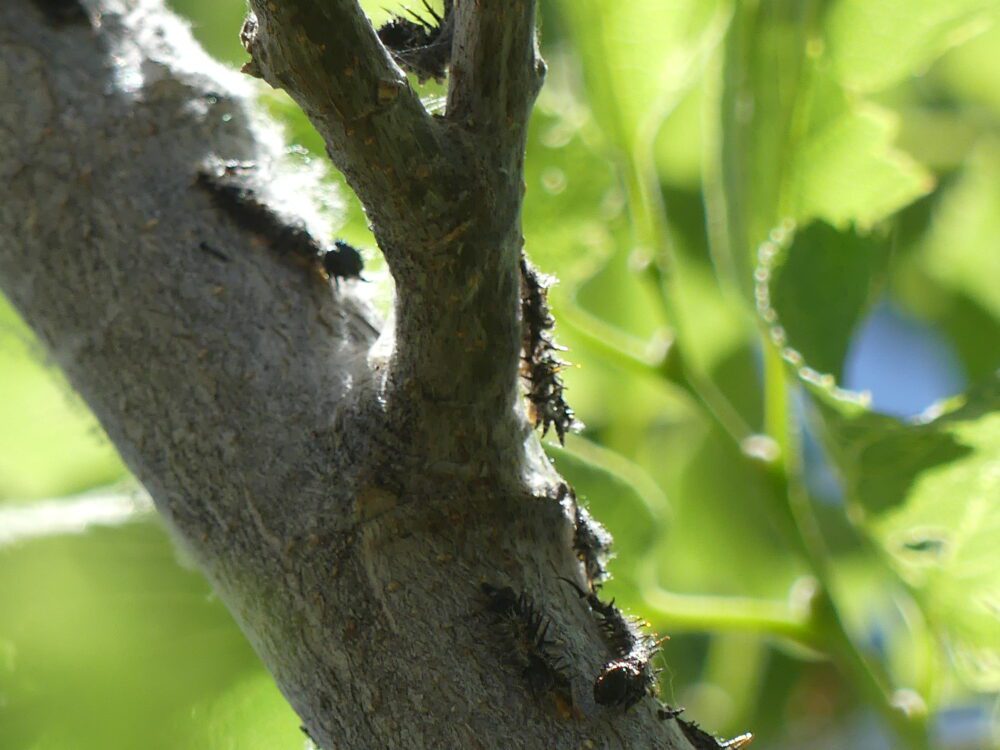
On the plus side, I did find one chrysalis (see image 11). Mourning Cloaks are designed to suspend the chrysalis from an overhanging substrate, like a tree branch in nature, but often under bridges and eaves provided by ever helpful humans. This one hangs from the ceiling of the entrance portal of RDAC’s administration building. It will be easy to keep an eye on it there. To be honest, I’m not sure this is a Mourning Cloak because many tortoiseshells (of which Mourning Cloak is one) make and hang very similar chrysalids. Time will tell.
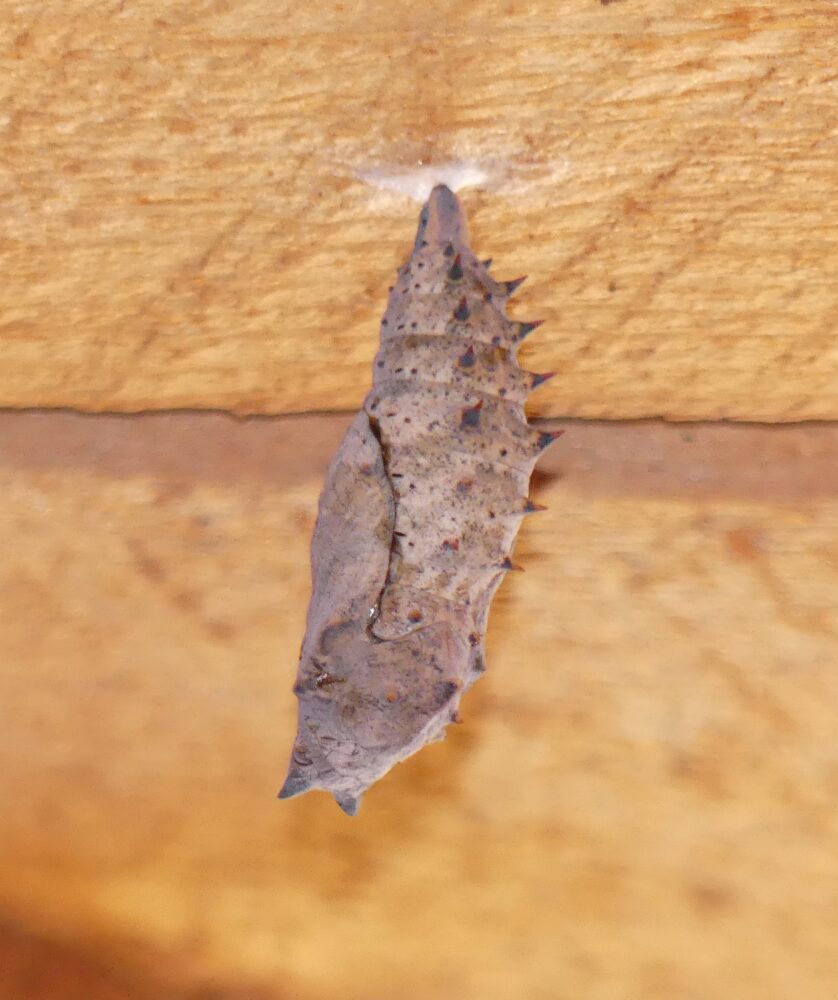
Despite the high mortality of larvae (which was completely expected) we have the promise of at least one adult mourning cloak in a few weeks, when the summer brood ecloses. It is likely that there are a few additional chrysalises scattered in the immediate neighborhood. I looked briefly and could not find any – so “good job” by them for hiding so well!
Rearing Viola’s Oak Hairstreak (Satyrium favonius violae), by Bill Beck. I’m very interested in hairstreaks in general, and especially those around Arizona and New Mexico. It’s no surprise then that I wanted to raise a few so I might observe and document their life cycles. Both the literature and recollections from friend Jim Brock had me hooked, so I invite you to read on . . .
There lives a hairstreak in the oaks of the very northeastern corner of New Mexico that, in 1947, was described to be a subspecies of the Oak Hairstreak (Satyrium favonius violae). (See Stallings and Turner. (1947). A New Subspecies of Butterfly. The Pan-Pacific Entomologist, 23 (1-4), 119-120.)
Here it was compared to its assumed closest kin, the Northern oak (S. f. ontario), the Texas oak (S. f. autolycus), and the Ilavia hairstreak (S. ilavia). They found it at 5600-5700 feet elevation on oaks. If one looks on the BAMONA map of records of Oak hairstreaks, there indeed seems to be quite a gap between the Oklahoma and Texas Oak hairstreak records, and those in northeast New Mexico. Satyrium f. violae is found elsewhere (including the Sacramento Mountains, Otero County) and we don’t quite understand its relationship to other Oak hairstreaks YET (underway), but it sure seems to be an endemic New Mexican!
Another interesting tidbit is that this area in northeast New Mexico seems to have lots of oak, but it’s a little different than the typical Gambel’s oak (Quercus gambelii) you might expect. It is Quercus undulata, a probable hybrid between Q. gambelii, Q. grisea, and Q. turbinella. (See Tucker, John M. (1961). Studies in the Quercus undulata Complex. American Journal of Botany, 48 (3), 202-208).
I’ve made the trip from Tucson up to Raton/Folsom looking for them for several years and times in late June. They seem nowhere to be found in dry years, but not too uncommon in good years. At least that’s my experience. My goal was to find not only the butterfly, but also a female and some viable eggs. When found, these Oak hairstreaks can be way up in tall oak trees, but also down lower in oak brush, the 10-15 foot variety. Lots of looking ahead. The area where I found them had many Banded hairstreaks (Satyrium calanus) and a few Colorados (Hypaurotis crysalus) right in the same trees. If you do it right, and find them during their short adult mating time of a couple weeks, you will be lucky. I guess I was very lucky!
LETS DO THIS!


I netted a couple females and males, put them with a few of their host tree branches in a screened cage, gave them water and flowers for sustenance (though oak hairstreaks often just use oak sap or “honeydew”), kept them at ambient temperatures somewhat and exposed to natural sunlight a few hours daily (see image 12). After a couple days ….….. eggs were oviposited; most at the twig joints where new growth had started this current year (see image 13).
Well, this is not the end but the beginning of your “life cycle” journey. It’s late June or early July now. The eggs of Satyrium hairstreaks (unlike most other Eumaeni hairstreaks) don’t hatch until NEXT early spring, when the oaks just start budding. The timing of hatching with “bud bursting” is an intriguing subject in its own right! How do they do it?
The eggs have some limited summer development, but soon go into diapause. One must keep the eggs nice and humid and cool until October or so, and then into your refrigerator for near freezing temperatures to mimic the winter months … for maybe 100 days. This has to be humid cold, not dry cold. You don’t want a modern “frostless” fridge. Put water in the refrigerator or manage the humidity in some manner or the eggs will desiccate and die. If the eggs get sufficient cold, then getting them warm will trigger the diapause switch and they will hatch.


You must have appropriate food ready, especially for the first hatch instars, or they wont live a day. And thus you need easy host plant access; time your removal of eggs from the refridgerator, at the exact time you have buds just barely bursting. Once out of the fridge, at room temperature the eggs will hatch in days up to maybe a week or two. Get the hatchlings right on the buds (see images 14 and 15) or they quickly desiccate and perish. If you do it wrong, then you start A YEAR over again. Ouch. I know. Get the host plant and timing right, and it feels GOOD!
Here it the southwest, WATCH the temperatures and humidity very closely. Keep the caterpillars in humidity, with daily or every other day new food, and watch them grow. I have raised the other oak-eating hairstreaks…..Poling’s, Ilavia, Goldhunter’s, and now Favonius “Violae” oak hairstreaks, and they all appear to eat exclusively, or at least preferentially, newly emerging oak catkins (see images 16 and 17). I’m sure this is the very best, least toxic, most nutritional food that the tree puts out. No wonder they like it.


The caterpillars grow fast, and go through molting four times. Each molt at about every 3 to 5 days. Each succeeding instar is, amazingly, a different “beast” in terms of size, shape, colors, setae, etc. After their largest and last instar, they stop eating….crawl around a lot (in the wild they climb down the trunk to the ground), eventually they find a spot to transform. But first they shrink into a pre-pupal form and loose their color, then they molt their last instar skin to expose the newly formed pupae. (See images 18 and 19).


They live as pupae for about two or three weeks as they transform into the adults. Eclosing of the adults from the pupae of your life-cycle study is a great feeling. The adults, thusly hatched, (see image 20) are all ready for immediate courting and mating, and the females can be laying eggs in just a day or two. It’s taken a whole year of your time, but the circle of life now continues as you picked it up from a year before.

It’s amazing, and IT’S Awesome.
SJC: You get no argument from me Bill. I love it. But I have a question . . . how/where do you get the fresh oak sprigs/twigs bearing the flower catkins to feed the larvae?
Bill: Well, in this case, I used Gambel’s oak catkins. I got some at Jemez Springs when I was in Albuquerque in March, I think. The catkins age pretty fast so you have to have a pretty good source. I ran out of the Jemez oaks, but there is Gambel’s oak up on the very top of the Santa Catalinas here in Tucson…..so I got more up there, but just barely made it. I get a gallon Ziploc baggy, moisten the twigs, and they keep pretty well in the refrigerator for two weeks or so. The trick is to first harvest the early catkins, then hatch the eggs, always keeping fresh catkins for the larvae. In any one place the catkins really don’t stay on the trees without aging away in just a couple weeks, so there are some road trips involved.
SJC: You put on quite a show, Bill, and you did it for another one of New Mexico’s most interesting and least studied hairstreaks. My personal favorite instar is the model with the pink racing stripe. Thanks so much for doing what you do and for telling the fascinating tale!
Socorro County’s Magdalena Mountains were the center of attention for many NM butterfliers in recent weeks. I don’t think Marta, Rebecca, Joe, Matt, or Bonnie coordinated their efforts, but for some reason they all made their way to the Magdalenas, specifically to Water Canyon, between May 25 and June 2; I suppose that is Memorial Day week. While most of NM continued to desiccate in our intensifying annual dry season, Water Canyon fulfilled the promise of its name. It had some wet spots and enough nectar to pull in a variety of butterflies . . .
Stirring that Pitcher of Margaritas, by Matt Brown (with some minor comments by SJC). Matt: Steve, I’ve gotten quite interested in the whole Atrytonopsis python/margarita thing. I know you’ve read and referenced Burns’ 2015 paper on Atrytonopsis, but I wanted to call your attention to figure 47 on page 284 of the Journal of the Lepidopterists Society, in case you (doubtfully) missed it. One of the female python specimens used to illustrate genitalia differences was taken “2.5 mi. NE of San Lorenzo, Black Range, 6200ft., Grant Co., NM” [the other, fig. 48, was from South West Research Station in the Chiricahuas]. So python, as you probably know, is confirmed for New Mexico! Your 1992 photo from the Cooke’s Range north of Deming, which can be viewed in Butterflies of New Mexico here, is only ~25 mile SSE of confirmed python presence (at least on May 28, 1959). Support for your potential python ID is provided. Since python is confirmed from the currently blazing Black Range, and because margarita is confirmed from the Jemez Mountains, I thought something interesting might be going on in between.
SJC: Matt, I first thank you for clarifying that python definitely occurs in Southwest New Mexico. For some reason I had not grasped that, but it clearly is true and A. python is confirmed from Grant and Luna counties. Butterflies of New Mexico will be tuned up accordingly! Second, the Magdalena Mountains lie in a biogeographical blend zone, having some Rocky Mountain butterflies and some Southwestern species, so it not at all unreasonable to speculate that northern A. margarita and southwestern A. python might co-occur there. A very worthy line of investigation!!
Matt: To that end, I spent a couple days in late May up in Water Canyon in the Magdalenas and I’m wondering if both python and margarita were flying together up there (along with the more-common A. vierecki). I was hoping you’d have time to take a look at my Flickr photos to see what you think: https://flic.kr/ps/zUTe8. [See images 21 and 22 below.] I’m going strictly on ventral hindwing spot colors, since I couldn’t get any open-wing shots. At least two individuals had orange hyaline post-median spots (as well as the separate discal spot, if present), while the rest of them had white-to-lightly-yellowed spots in those areas (again, ventrally).
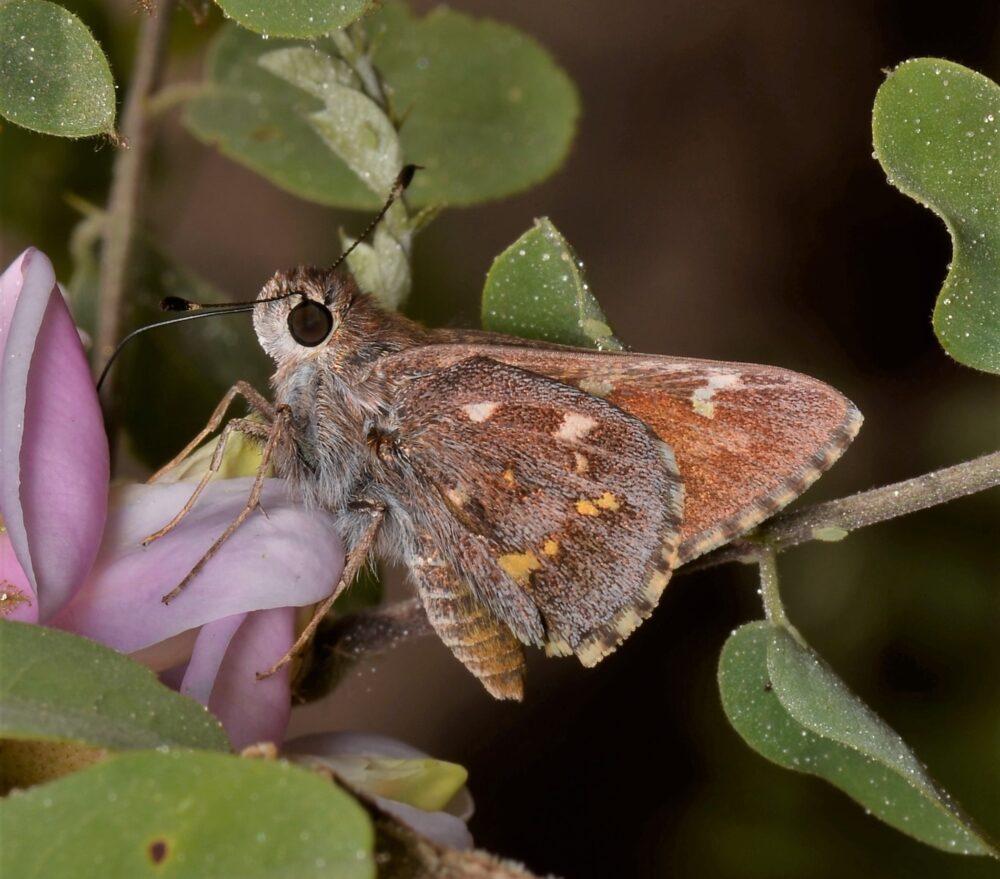
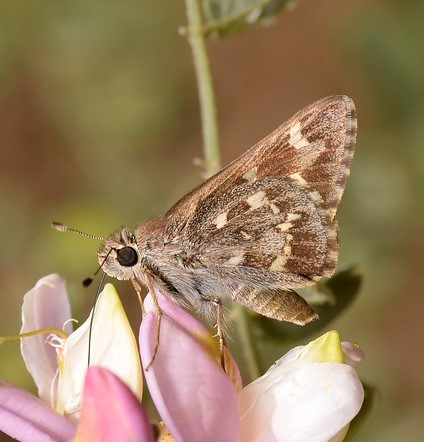
SJC: Matt, these are all terrific images of Atrytonopsis from Water Canyon. Thank you for bringing them to my attention. You have posed a nice hypothesis that python and margarita were each present, and you have proposed a new way to distinguish them. The only way I know to distinguish them requires views of the uppersides, which I understand were not available to you. I have never before observed the yellow/orange ventral cast. The situation definitely merits follow-up in 2023. Somehow, we need to be able to cross-correlate dorsal and ventral markings, and probably genitalia or DNA as well. Don’t you think?
Matt: My ultimate goals are to see if A. margarita gets into southeast AZ (I suspect they continue west into the AZ Central Highlands), and if they are field-separable ventrally, but also to see how far east into NM A. python gets. If you scroll down a bit in the Flickr photostream, you’ll see a python I shot in the Chiricahuas a week ago. . . . More as it unfolds… Matt Brown, The Patagonia Birding & Butterfly Co.
SJC: Those are commendable goals, Matt, and given the state of our understanding of this group, I suspect you will harvest gold in your efforts. Along that line of potentially overlapping distributions, though, I wonder about that “python” you mention in the paragraph above, which you photographed in the Chiricahuas on May 20. It does not seem to have the orange ventral scaling exhibited by two of your putative python from Water Canyon. So could that Chiricahua critter be margarita? Frankly, I often rely on the location of a sighting to identify it. It really is a kind of crutch, which I pull out when I cannot pick out physical characters on which to base a decision. When that crutch is yanked away, as you are suggesting here, then I start to wobble. In any case, you have laid out a terrific field project for Memorial Day week in 2023. Would you like any assistance? Thanks for stirring that pitcher!
Life History of Viereck’s Skipper – We Have an Egg! Immature stages and life histories for several skippers in the genus Atrytonopsis – the Dusted Skippers – remain very poorly understood. Arizona butterfly guru Jim Brock told me recently that life histories for the May-June flying Atrytonopsis species of Arizona and New Mexico (i.e., margarita, python, deva and vierecki) were almost entirely unknown; zero host plants were confirmed; zero immature stages were documented; courtship and mating had not been observed; oviposition had not been recorded. I racked my brain and had to agree, in 80 years (40 for him, 40 for me, and he was really looking) we had documented few to none of these fundamental life-cycle events for any of those species.
Clearly there needed to be more observers involved and Jim was doing some recruiting. Elaine Halbedel reported in last month’s blog that she had signed on as one of Jim’s scouts for Viereck’s Skipper and was keeping her eyes open for ovipositions. I was doing the same and starting to think about how to spread the word to friends and colleagues, like all of you readers. Jim was eager to see what I would put together, suggesting that “a single oviposition witnessed by somebody would certainly be a home run.”
Viereck’s Skipper sightings in NM had been coming in to BAMONA slowly and steadily since about May 10. On May 25, Matt Brown saw them in good numbers in Water Canyon, most nectaring at thistles and NM locust flowers. Then, on May 30, Marta Reece was in the Water Canyon area and shared some photos with her regular correspondents, of which I am fortunate to be one. Her first image (see image 23) shows an Atrytonopsis with a large abdomen; I first thought it was a gravid (egg-laden) female. As to species, I ruled out Margarita and Python because of the unchecked hindwing fringe. I ruled out Deva because Marta also snapped a pic showing the upperside in mid-flap as she took off (see image 24). Putting two and two together, I tentatively concluded she had photographed a gravid female Viereck’s Skipper. I reached out to Jim Brock and he agreed it was a female Viereck’s Skipper, but probably just recently out of chrysalis, not gravid.
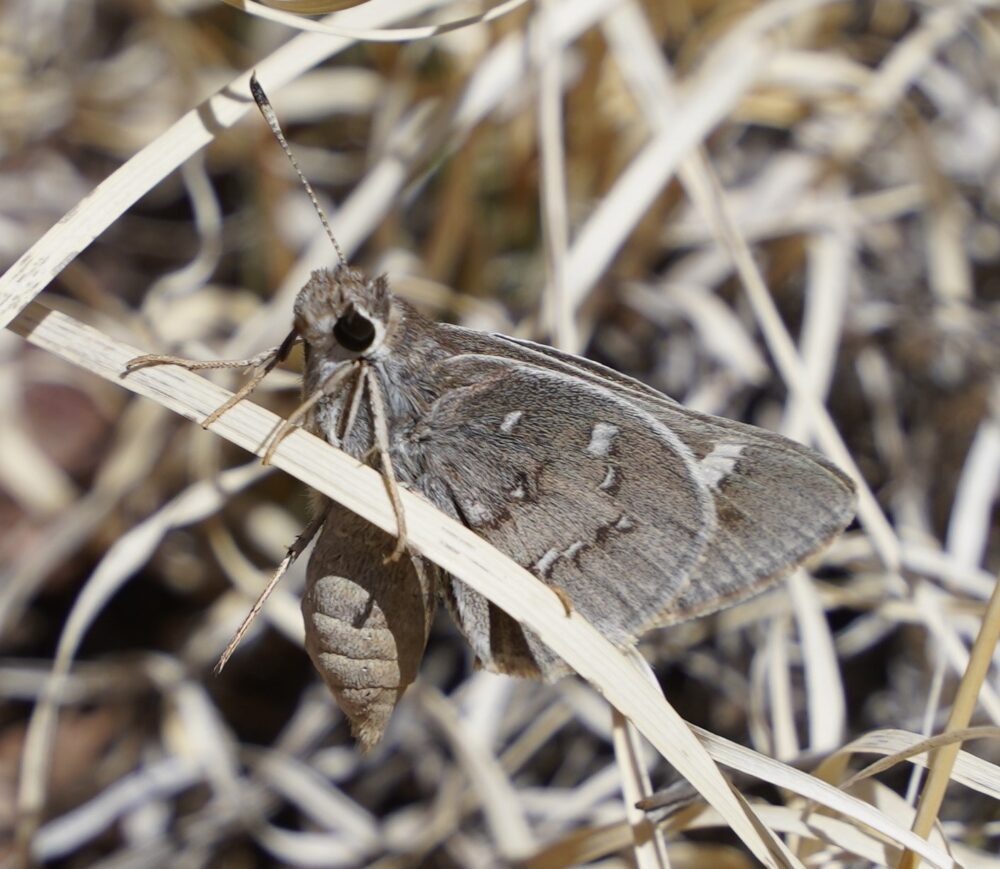

These, and Marta’s other images, depicted the habitat in which this female had begun life as an egg herself, then fed, grown and pupated; we could see some of the grasses that were present. Marta’s images were taken atop a ridge adjacent to Water Canyon, not in a canyon bottom, and I allowed myself to think that might give us a better idea of where in the landscape to look for those elusive ovipositions.
On June 6, Jim started the long and arduous process of educating me about what I was getting myself into: “Some of these Atrytonopsis life histories remain unknown due to a couple of things: (1) You almost never see an oviposition, and, then, when you are lucky enough to witness the female in the act, poof, she is gone! I mean they lay and then jet away, and you have to decide whether to mark the grass & look for the egg or to follow her to her next stop. (2) The other difficulty is finding larvae in the field.” Jim related some of his efforts and frustrations in tracking down immature stages of White-barred Skipper (Atrytonopsis pittacus) in the Tucson area. Adjectives including elusive, enigmatic, and inscrutable come to mind, but he was able to make some progress, finding that white-barred females place eggs on “big-leaf grasses like side oats grama (Bouteloua curtipendula) and/or bull grass (Muhlenbergia). Why do they need big leaves? Well, they make aerial nests in early instars and thin-leaved grasses like blue grama (Bouteloua gracilis) won’t support this. That narrows down the search and the number of potential grasses in any given habitat.”
I was checking my emails at 4:30 PM on the hot afternoon of June 9 and I saw one from Rene Laubach who wanted some help with identification of a skipper – that always sucks me in and he knows it. He and Christyna had been hiking and naturalizing Cerrillos Hills State Park (southern Santa Fe County) earlier that day. Take a look at his two photos of the same individual (see images 25 and 26) and I think you’ll agree it is Viereck’s Skipper, which is a regular May flyer at Cerrillos Hills. It’s not a WOW butterfly there, but the WOW happens when you see what this female is doing. She is pushing an egg onto a dry grass stem.
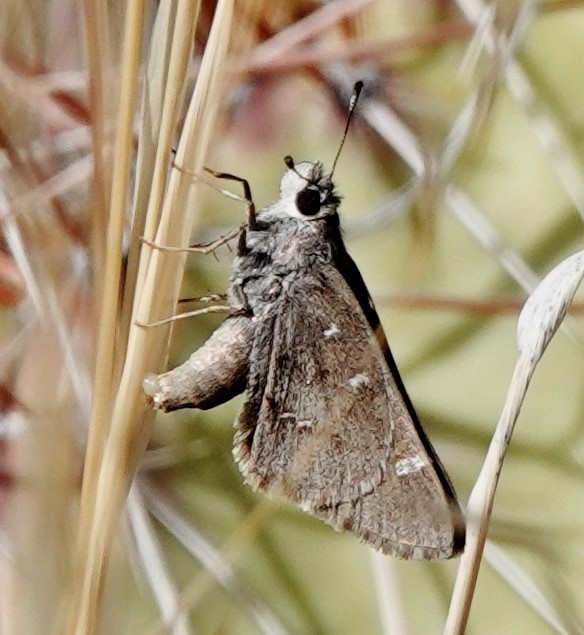
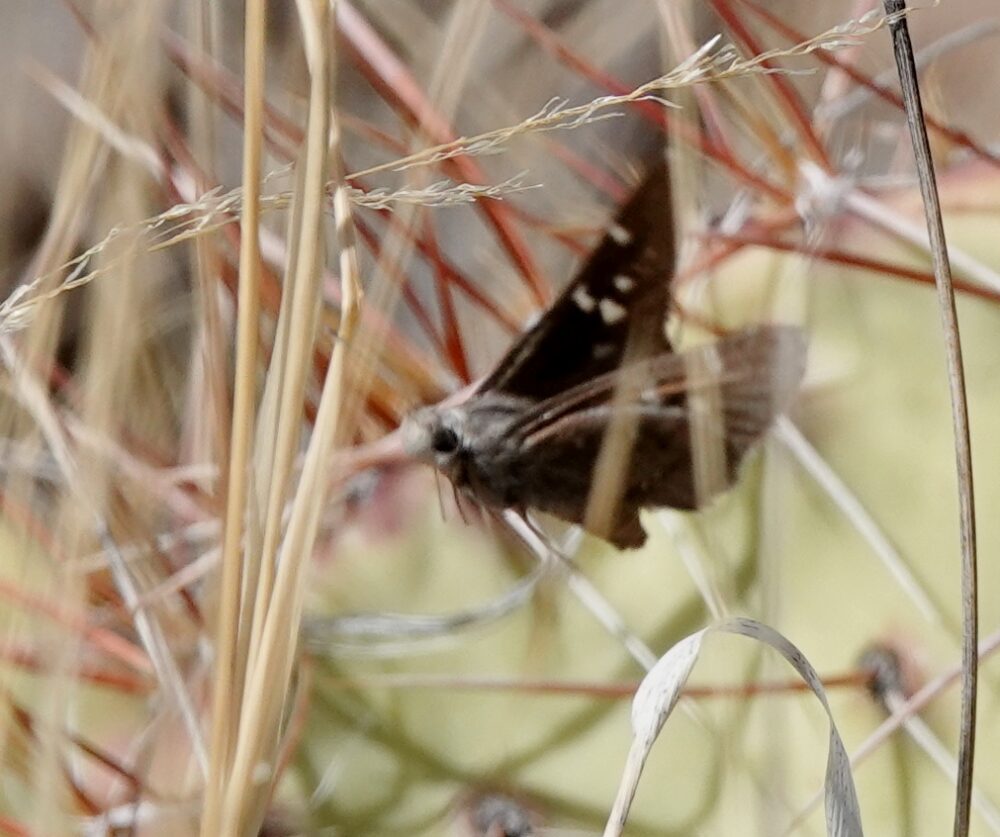
Rene and Christyna did not immediately notice that this was a female placing an egg, but fortunately Rene kept snapping while this beauty flew away and revealed the hourglass-shaped cell spot that confirms it as A. vierecki (see image 27).
Two days later, June 11, Rene and Christyna showed me the place where they took these photos and we were able to find the egg in a few minutes (see image 27). Kind of a miracle, but heck, Rene’s photos led us right to the grass and the egg. In coordination with park manager Peter Lipscomb, we GPSed the location, flagged it and further documented it. We still need to get the grass identified, but it is a relatively tall grass with relatively big leaves, just as Jim found for A. pittacus near Tucson. It will be easier to identify after it greens up and produces flowers.
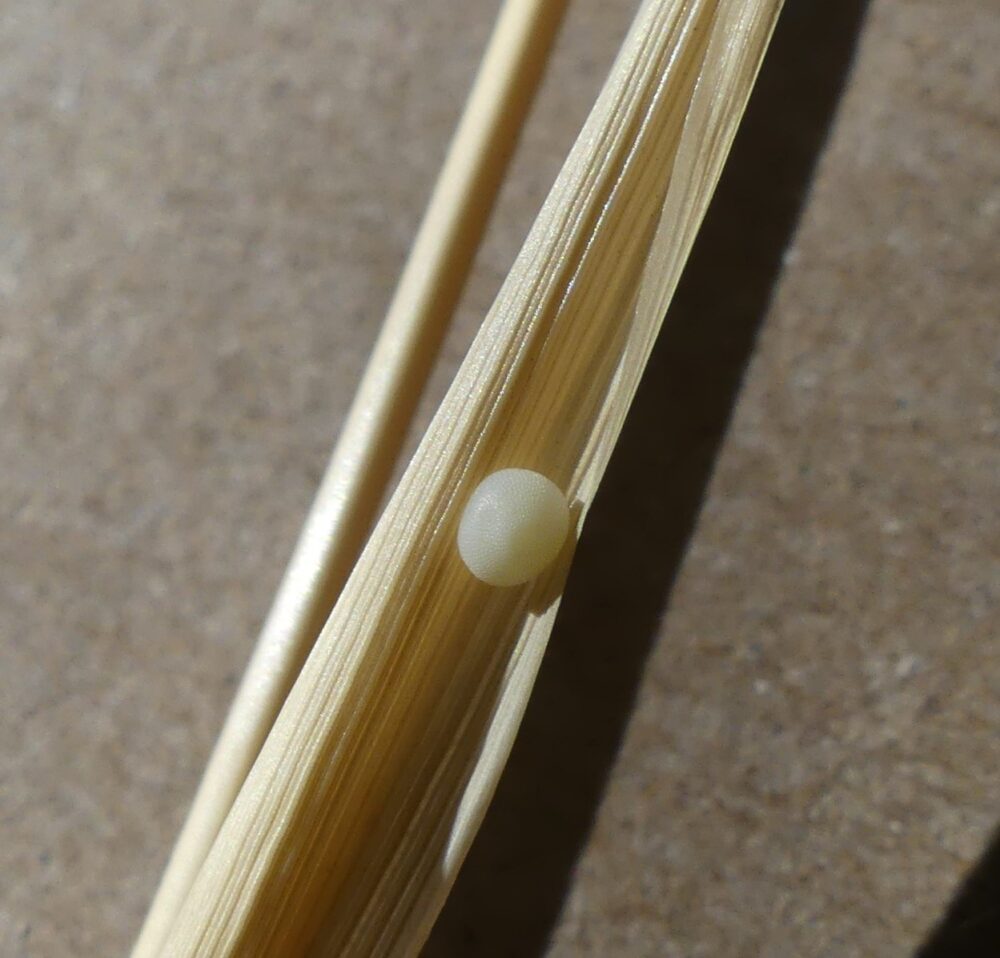
The early June oviposition and the egg have forced me to confront the fact that Viereck’s Skipper, and perhaps sister species Deva, Python, Margarita and White-barred, all violate a general rule of thumb, namely that butterfly species time their life cycles so they can place their eggs right when their larval host plants are at their most nutritious. Makes sense right? But here we have Viereck’s females placing eggs on last year’s dead grass stems right in the middle of our annual dry season. There were no edible/green grasses anywhere on the hills of Cerrillos Hills State Park, or pretty much anywhere in New Mexico, which is a sea of brown from horizon to horizon that will persist for an indefinite number of weeks into the future. This seems to be a gross violation of that rule. What’s that about?
Jim’s explanation, which seems plausible to me, is that these eggs are waiting for the rainy season. That’s still weeks away, but perhaps these species diapause as eggs. Or as Jim suggests, first instars hatch out, eat the remains of the egg (“like mother’s milk”), find shelter somewhere on the plant, or very nearby, and then enter what he calls a “feeding diapause.” After the monsoons do their thing, all the summer grasses should re-sprout, grow and become great food for grass-feeding larvae. Then it will be time to start paying closer attention. I guess we have to call it a hypothesis at this stage, because none of that is documented . . . yet. Here’s hoping that Jim can work with what we’ve found and undertake, with our help, the challenge of nursing this enigmatic organism through its immature stages, while we watch. Stay tuned for further developments.
The Disappearing Centipede. In his role as manager of Audubon New Mexico’s Randall Davey Audubon Center, in the foothills east of Santa Fe, Carl Beal sees a lot of things. A couple weeks ago, he encountered a centipede crossing a flagstone walkway in one of the gardens. The 4-inch centipede chose an unfortunate route because beneath the flagstone was an active any colony. The ants didn’t take kindly to the trespasser and attacked it. The much larger centipede continued on its path, but with ants clinging to it and biting it. See Carl’s photo and video below (image 28 and video 1).
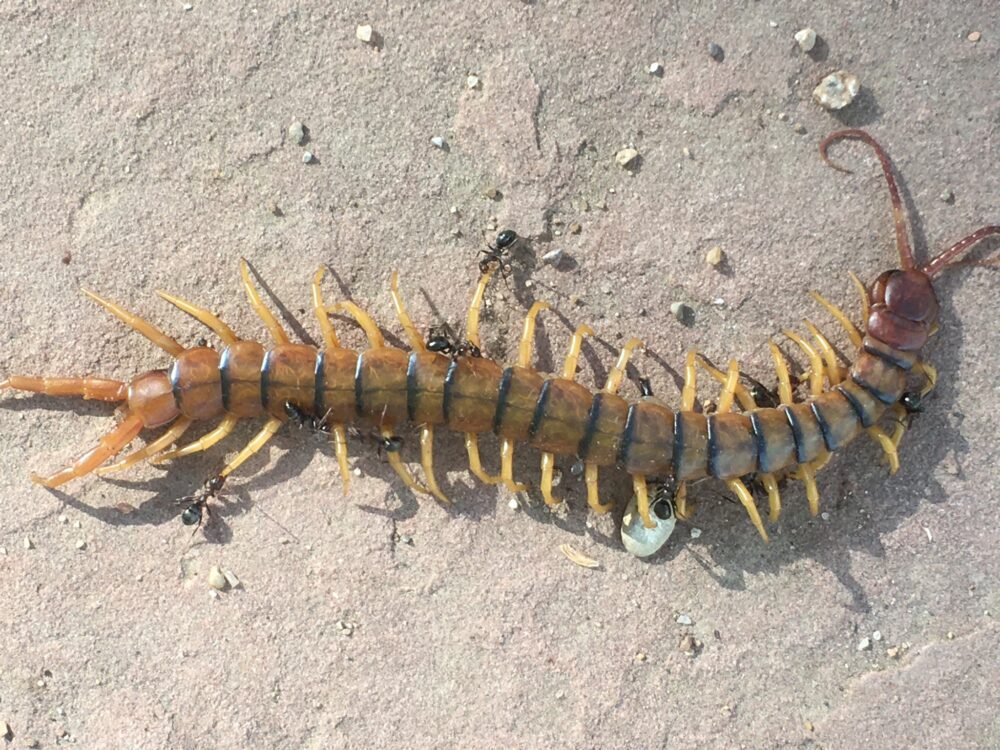
Carl continues with the story… A few minutes later, I and other “old guy” volunteer came upon the evolving scene. The centipede was off the flagstone, paralyzed or otherwise immobilized. Oddly, it was still moving, but its legs were not; it was under ant power. Gradually, sand grain by sand grain, ants were shifting the helpless centipede back toward and under the flagstone. Think about what must have been happening in the colony beneath the flagstone. What a team effort must have been required! Carl captured another final shot of the head of the disappearing centipede (see image 29). In the span of maybe 15 minutes it had been immobilized and brought into the ant colony, its fate horribly sealed.
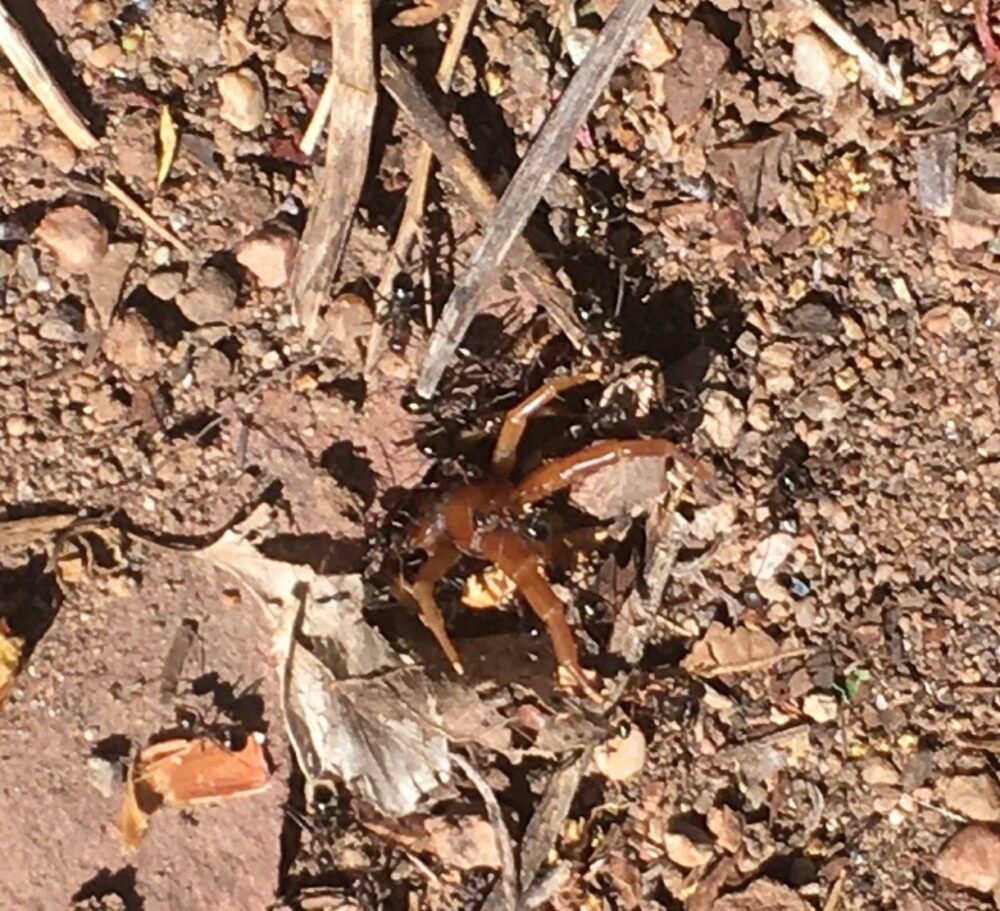
Quite a team those ants make. I always thought centipedes got a bad rap just because of their extremely non-mammalian appearance. I have even more sympathy for them now. And fellow humans, I ask you, what chance do we have against the ants in the long run?
Rains are coming. Allow two or three weeks for the plants to respond, then make the most of the opportunity!

I am very lucky to be on your list. I find all of your posts fasinating. I will definately be more aware of Atrytonopsis as I snap my pic’s!
Steve!
Amazing pictures and looks like it is Mourning vloak chrysalis.
Another fascinating thing about Python Skipper which last week I had on my deck purple bloom!
Last not least is Dorothy Hoard Butterfly count having three weeks is a superb idea.
Thank you.
Great blog, Steve, et al! The Red-winged Blackbird tale is very interesting. Some tropical Orioles have figured out how to eat toxic butterflies by stripping the guts out of the body and leaving the cuticle behind. The cuticle is often the site where the noxious chemicals are stored. As to why the RWB dropped the Pipevine, maybe taste, maybe he was just startled (or maybe he was tired of caring for his brood and wanted to poison a few 🙂 ).
I suspect a virus got the Mourning Cloak cats. When I tried raising this critter in NM many long years ago, I often lost the cats to two main culprits: virus and Tachinid flies.
Great job on violae and Atrytonopsis!
Hi Steve and thanks! Again you’ve exceeded my brain cell capacity to store information in a meaningful way – great stuff…On one hand I’m kind of bummed out by all the MC caterpillar demise but am glad to see a chrysalis which I can reference when out among the hackberry trees where I’ve seen a few MC caterpillars. Bill’s patience and dedication are beyond amazing – thank you for sharing your results and images!!! Thanks, Mike, for your toxic butterfly comments above – it helps to see the bigger story! And for that final looming question : “what chance do we have against the ants in the long run?” – I suggest an “Adopt a Horned Lizard” program…